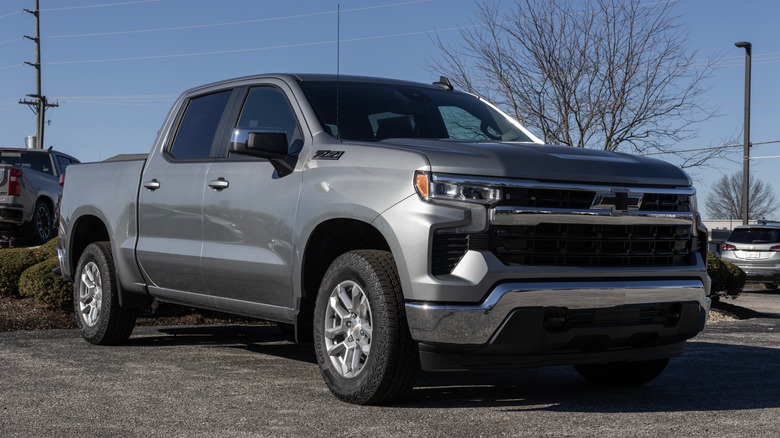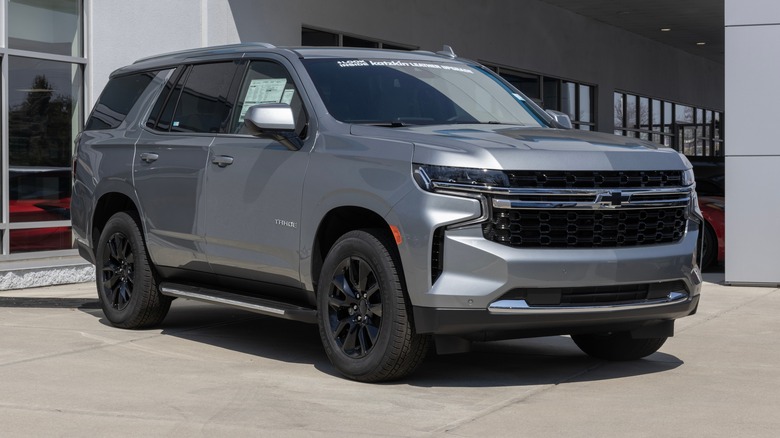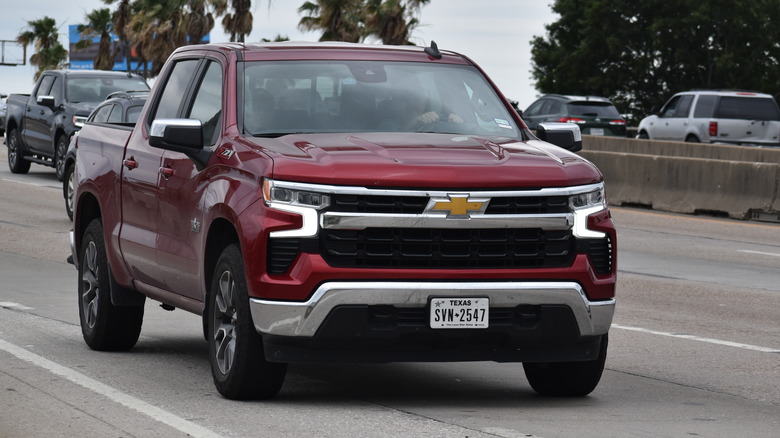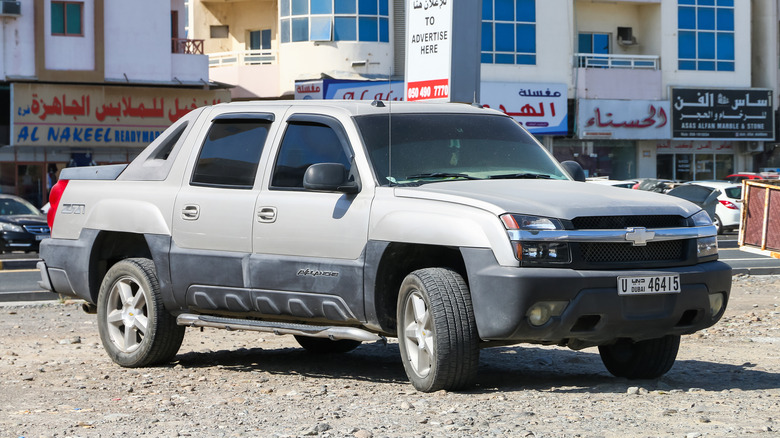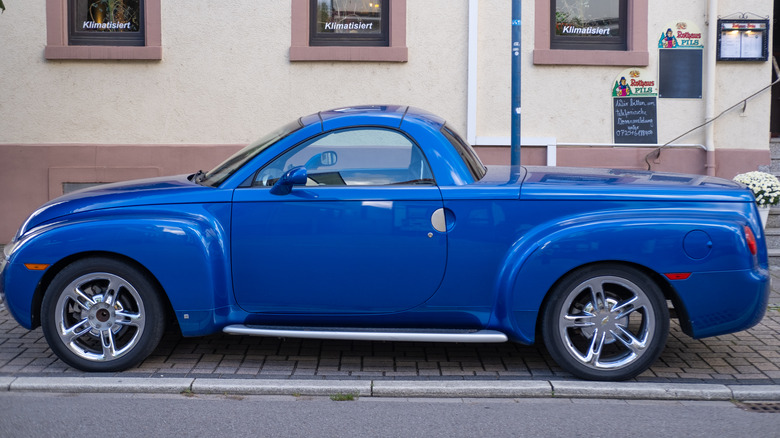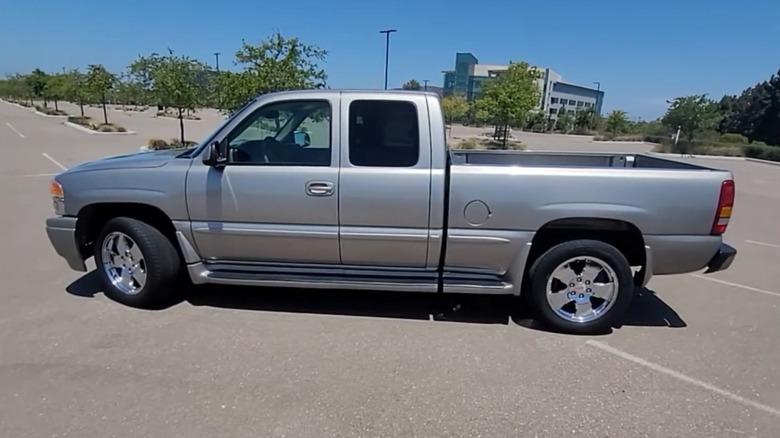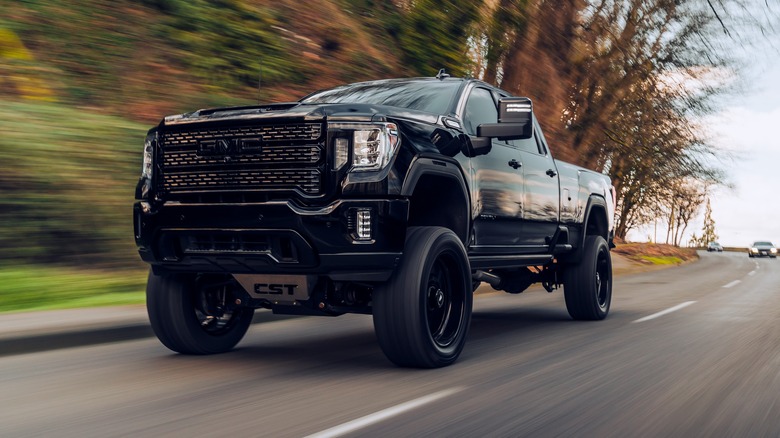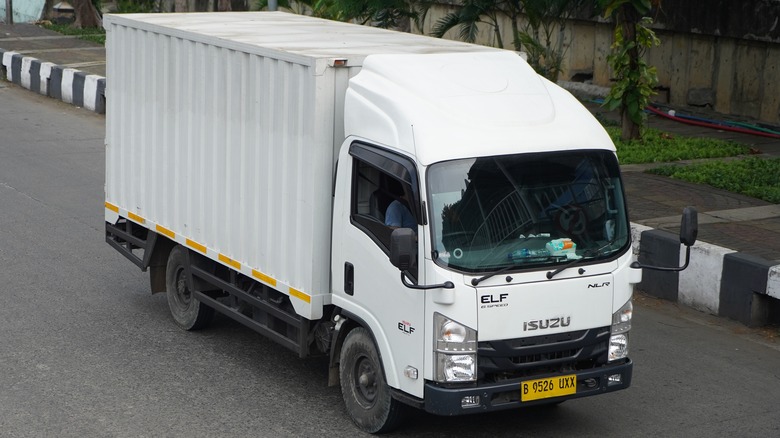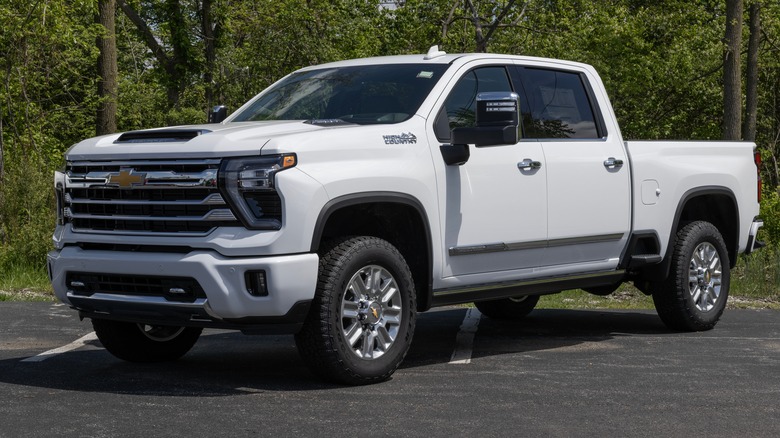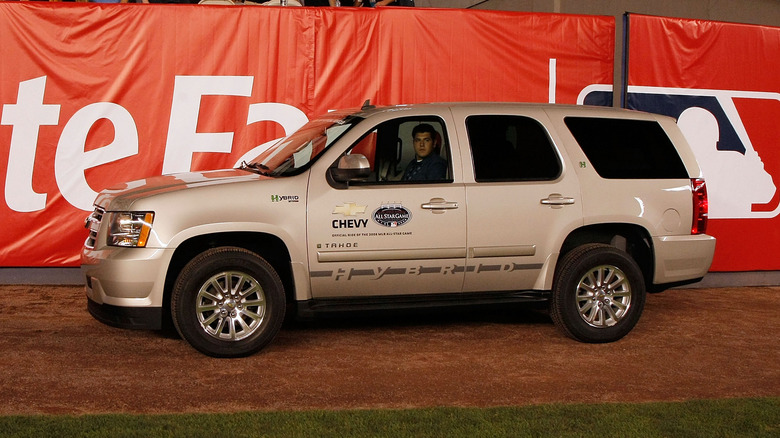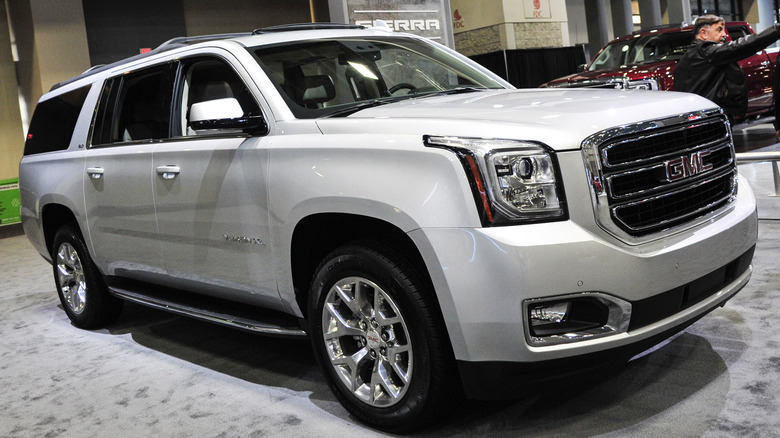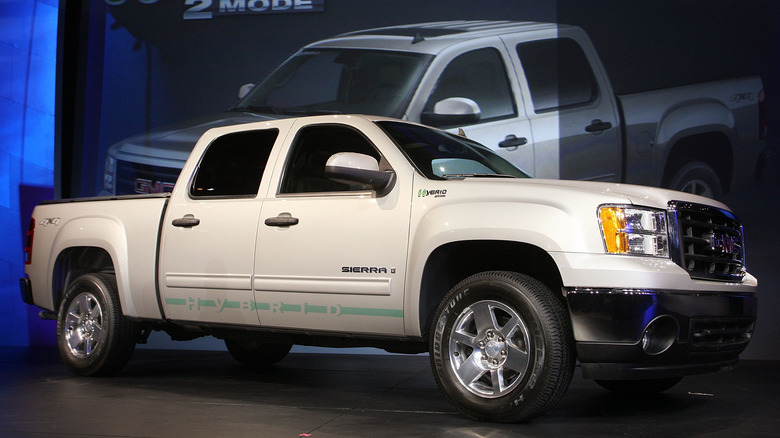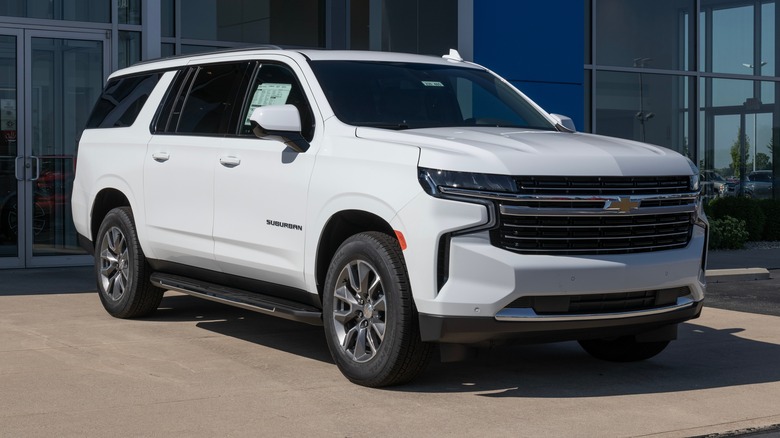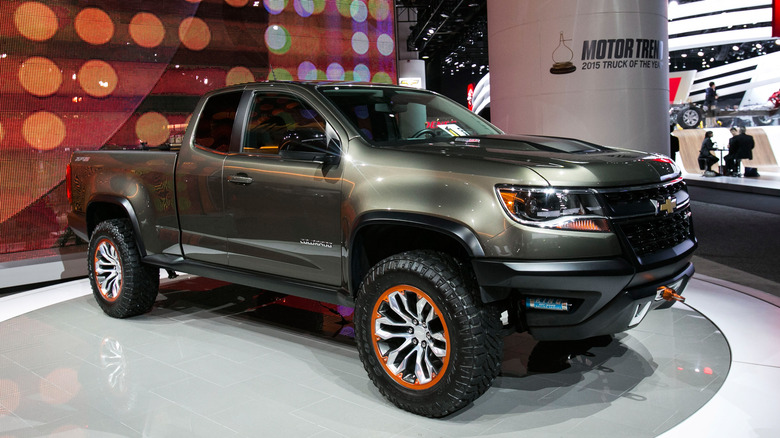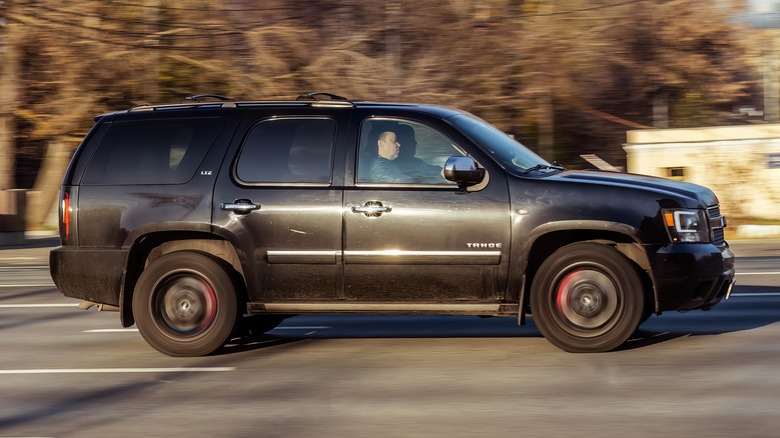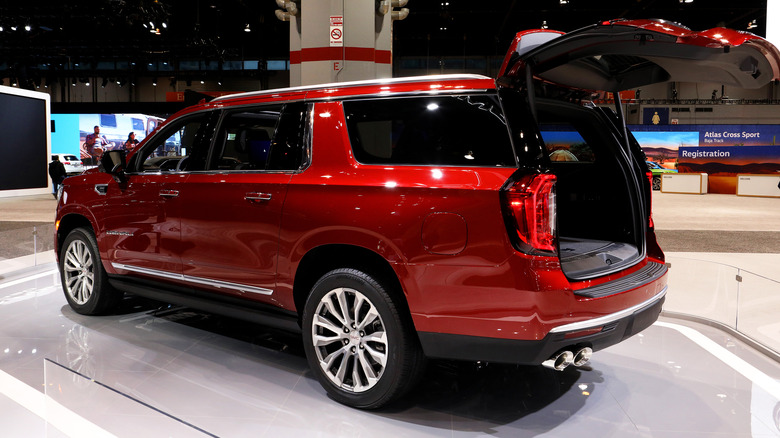Every Truck Powered By A General Motors LS V8 Engine
General Motors' LS crate engine is a series of popular V8 engines (and recently V6 engines) that punch well above their weight class. While these motors are small, they can deliver far more displacement and power than their sizes would indicate, due to a variety of features, including reverse-flow cylinder heads and specialized intake manifolds. Moreover, LS engines weigh less than rivals due to their aluminum constructions and fewer moving parts, which also makes these motors easier to maintain and repair. These factors give associated cars excellent weight distribution and handling, not just compared to other cars with V8 engines but in general as well.
The LS engine has been around since 1955 and seen numerous iterations. The motor block premiered in the C1 Chevy Corvette, one of car lovers' favorite Corvette models, and has gone on to power multiple generations of the Pontiac Firebird, the Hummer H2, and the Ginetta Akula, among others. However, the LS has primarily stuck to GM's own Chevrolet and GMC brands. While you can find LS engines in a variety of sedans and SUVs, such as the Chevy Camarro and GMC Envoy, General Motors has also used the engine to power quite a few trucks. Here's a complete list of every truck that came standard with at least one style of LS V8 engine.
Chevrolet Tahoe/GMC Yukon
When you think of a truck an average person might own, the open-bed design of an adventure-ready pickup truck probably springs to mind. However, when looking at a Chevy Tahoe, you might assume it's an SUV. In truth, the vehicle is actually an example of body-on-frame construction, as the Tahoe uses a truck frame as its skeleton. This design gives the Tahoe a robustness that blurs the line between SUV and truck.
On a side note, you might wonder why the GMC Yukon is part of this entry. That's because it is an example of badge engineering — the Yukon has same design and parts as the Tahoe, but a different insignia. That means it sits in the same class as the Tahoe: It's an SUV that is also a truck. However, while the Yukon is a rebadged Tahoe, it's not a carbon copy. It can tow more weight and has slightly more seating space and legroom for each passenger, albeit with worse fuel efficiency.
The Chevrolet Tahoe and GMC Yukon have utilized countless LS engines since the turn of the century. Some of these engine blocks included the 4.8-liter LR4 (aka The Vortec 4800) from 2000 to 2006, the 5.3-liter L59 from 2002 to 2006, and the 6.2-liter L86 from 2015 to the present day.
Chevrolet Silverado/GMC Sierra 1500
The Chevrolet Silverado 1500, more commonly known as just the Chevrolet Silverado, is the workhorse of General Motors' trucks and of trucks in general. The Silverado family has been reliably hauling cargo since 1999, and General Motors shows no sign of abandoning the model. Like the Tahoe, the Silverado has its own rebadge truck: the GMC Sierra 1500, or just GMC Sierra for short. While the Silverado and Sierra have undergone numerous changes throughout the years, the trucks have some of the best safety ratings on the market. However, due to their sizes, Silverados and Sierras have significant blind spots.
Since the Silverado/Sierra lines have been active for several decades, they have gone through more motors than possibly any other General Motors truck. You name an LS engine, you can probably find it in one of the Silverado models. These have included the 5.3-liter LM7 (aka The Vortec 5300) from 1999 to 2007, the 5.3-liter L33 and 4.8-liter LY2 from 2005 to 2007, and the 5.3-liter LC9 from 2007 to 2011.
Chevrolet Avalanche 1500
Most pickup trucks sacrifice passenger space for cargo capacity, but the Chevrolet Avalanche 1500, also known as the Chevrolet Avalanche, employed a workaround. The truck had enough room for five or six passengers and plenty of space in the back for luggage, but the back seats could also fold down for yet more cargo room. And unlike other trucks, the Avalanche sported a unique and eye-catching unibody design that merged the truck bed with the car cab — most truck designs separate the bed and cab. The secret behind the Avalanche's conversion capabilities was a "midgate," a plastic cover that sat behind the rear seats. Owners had to flip down the midgate along with the seats, but this transformed an SUV with a normal-sized truck bed to a standard truck with an extra-long bed.
Despite being a reliable Chevy truck that was dirt-cheap to maintain, the Avalanche was short lived, only running from 2002 to 2013. Regardless, the truck made full use of several LS engine models during its tenure. These included the 5.3-liter LM7 from 2002 to 2006, the 5.3-liter LY5 from 2007 to 2009, the 5.3-liter LC9 from 2007 to 2011, and the 5.3-liter LMG from 2007 to 2013.
Chevrolet SSR
In 2003, General Motors tried its luck producing a convertible pickup truck. Dubbed the Chevrolet Super Sport Roadster (SSR for short), the truck featured an open bed as usual, but it also sported bright candy-like colors, a rounded body that made it look even more candy-like, and a retractable hard-top roof. However, the Chevrolet SSR was a flop, but not just any flop: It was the flop to end all flops. The truck's sales performed poorly, and the vehicle's towing performance wasn't great either. Even though the truck weighed 4,760 pounds, it couldn't pull more than 2,500 — a little over half its weight. In 2006, General Motors stopped production and closed down the factory that manufactured the vehicle. That's a whole new level of bad.
Ironically, Chevrolet SSR was powered by hefty LS engines that made its towing capacity issues even more egregious. Depending on the model, the car sported either a 5.3-liter LM4 engine or a 6.0-liter LS2 engine. However, not even the LS2's increase in horsepower was enough to save the truck.
GMC Sierra C3
While many GMC Sierras belong to the long-running 1500 line, General Motors has produced a few more limited runs. One of the first was 2001's Sierra C3, which was touted as a pickup truck that not only out-towed its contemporary rivals but also provided superior handling and smoother rides. While the Sierra C3 used the same basic frame as prior Sierra trucks, its transmission, engine, and suspension systems were all brand new. According to Sierra brand manager Jim Kornas truck's back also wouldn't bounce up and down when unloaded, something of an Achilles' heel for many pickup trucks.
When we say the GMC Sierra C3 was a limited run, we mean it. General Motors made just 10,000-15,000 C3 trucks, which makes it a bit of a collector's item. Since production lasted around a year, General Motors only put one style of LS V8 motor into the vehicle: the 6.0-liter LQ4, also known as the Vortec 6000.
GMC Sierra Denali
The GMC Sierra Denali is technically a variant of the GMC Sierra 1500, but it's got so many bells and whistles that it might as well be its own thing. Take the modern iterations as an example. Compared to your standard Sierra, the Denali comes with bigger wheels made out of aluminum, superior transmission, side door steps, trailer hitches, and a bed-view camera. The Denali also has access to more optional accessories and sidegrades, including diesel engines, premium front and rear floor liners, a console-mounted safe, and a heads-up display (HUD) for the windshield. Essentially, the Denali is a luxury-centric Sierra, and that's reflected in the price.
The GMC Sierra Denali has so far only used LS engines such as the 6.0-liter LQ4 from 2002 to 2004, the 6.0-liter LQ9 from 2005 to 2006, and the 6.2-liter L92 from 2007 to 2008. While vanilla Sierra models haven't utilized these engines, the 2002 Denali shared the LQ4 with some Sierra heavy duty (HD) variants, although the Denali's cranked out more horsepower and torque.
Isuzu Elf/Chevrolet W-Series/GMC W-Series/Isuzu NPR
There are lots of cars you probably didn't realize were rebadged — sometimes it happens to save money, while other times it's to help market them overseas. The Isuzu Elf is an example of the latter and a confusing one at that. This medium-sized flat nose truck, also known as the Isuzu N-series, originated in Japan under the manufacturer Isuzu. The truck could be outfitted to carry a variety of loads, and later models sported a tilting cab. In some countries, it isn't uncommon for an Isuzu Elf to be converted into a van, or at least retrofitted to resemble one. To sell the truck in the United States, Chevrolet gained permission to rebrand the Elf as the Chevy W-series, but the truck has also gone by names such as the Low Cab Forward and Tiltmaster. General Motors also rebadged the Chevy rebadge to sell the Isuzu Elf as the GMC W-Series.
While Isuzu has manufactured the Isuzu Elf since 1959, different truck models have utilized different engines throughout the Elf's long lifespan — some built by Isuzu, others by General Motors. While one was an LS engine, the 6.0-liter LQ4, this motor only graced Isuzu Elfs from 2003 to 2008.
Chevrolet Silverado 2500HD/3500HD/GMC Sierra 2500HD/3500HD
Like the Chevrolet Silverado C3 and Denali, the Silverado 2500HD and 3500HD are as much variations on the Chevy Silverado 1500 as they are their own beasts. The same applies to the GMC Sierra 2500HD and 3500HD due to rebadging. Again, let's compare the modern iterations of the 2500HD and 3500HD to the 1500. The 2500HD and 3500HDs sport longer beds to haul more freight, as well as stronger engines with more transmission speed options. Customers can also kit out the HD trucks with add-ons unavailable to the standard Silverado, including towing/hitching options, rear parking assist and lane change alerts, and winter grille covers. The 2500HD and 3500HD truly live up to the "HD" label (which doesn't stand for "high definition"). Of course, the 2500HD and 3500HD are more expensive, but you get what you pay for, and you just get more with these vehicles.
Again following in the footsteps of the Sierra 1500, the Sierra 2500HD and 3500HD have wielded numerous engines throughout the years, some of which came from General Motors' LS line. These have included the 6.0-liter LY6 from 2007 and 2010 and the 6.0-liter L96 from 2010 to 2017. Starting in 2015, Silverado and Sierra models have taken advantage of one of the latest LS engines, the 6.6-liter L8T. You can still buy a heavy duty Silverado or Sierra truck with this engine.
Chevrolet Tahoe Hybrid/GMC Yukon Hybrid
While General Motors mostly specializes in gas and diesel-powered engines, the company has a pretty long history of dipping its toes into the electric vehicle and hybrid motor waters. One such experiment consisted of the 2008 Chevrolet Tahoe Hybrid and the rebadged GMC Yukon Hybrid. Like the vanilla Tahoe, the Tahoe Hybrid blurred the line between truck and SUV thanks to its body-on-frame construction. This truck also used a series of hybrid technologies, then officially known as Advanced Hybrid System 2, that General Motors designed for its cars. This system consisted of automatic transmission planetary gearsets that reduced the amount of mechanical power that had to be converted to electricity to maintain transmission operation. Other than the gearsets and the engine, the Tahoe Hybrid was the same Chevy Tahoe drivers and passengers had grown to love.
Unfortunately, the Chevy Tahoe Hybrid failed to make an impact, as did the GMC Yukon Hybrid. Not only did the vehicles release when the housing bubble burst, but the Tahoe Hybrid lagged behind its contemporary competitors in fuel economy. Still, this hauler got better gas mileage than the normal Tahoe thanks to its 6.0-liter LFA and 6.0-liter LZ1 engines, which were utilized between 2008 and 2009 and between 2010 and 2013, respectively.
GMC Yukon XL 1500
Just as General Motors offers souped-up versions of the Chevrolet Sierra 1500 via the Sierra 2500HD and 3500HD, the company tried something similar with the GMC Yukon XL 1500 (or just Yukon XL for short). True to its name, this Schrodinger's SUV is larger than the standard Yukon 1500 — not only is it longer, with more passenger room and cargo space, but it also features a wider wheelbase. However, the Yukon XL can't tow as much as the standard Yukon. Despite these differences in dimensions, the GMC Yukon XL costs as much as a standard Yukon and even includes the same customization options, such as panoramic sunroofs, automatic emergency braking, and adaptive cruise control.
The GMC Yukon XL has shared many engines with standard Yukon 1500 models. These included LS motors such as the 5.3-liter LMG from 2007 and 2014 and the 5.3-liter LY5, from 2007 to 2009. These identical engine inclusions might explain why the Yukon XL lags behind the regular Yukon's towing capabilities; the same motor is pulling more car weight and has less left over for additional freight.
Chevrolet Silverado Hybrid/GMC Sierra Hybrid
General Motors (and other car manufacturers) likes to repeat certain ideas, including experimenting with hybrid designs. The Chevrolet Silverado and rebadged GMC Sierra Hybrids were, like the Chevrolet Tahoe and GMC Yukon Hybrids, exactly as their names advertised: otherwise very similar hybrid versions of the already popular trucks. And like the Yukon and Tahoe hybrids, these didn't exactly light the world on fire either. General Motors quietly canceled the hybrid Silverado and Sierra lines in 2012, but the company brought back the hybrid haulers for a limited time between 2016 and 2018.
The original run of Silverado and Sierra Hybrids shared the same engines as the Tahoe and Yukon Hybrids — the 6.0-liter LFA from 2008 to 2009 and the 6.0-liter LZ1 from 2010 to 2013. However, the 2016 to 2018 versions used an entirely different engine, the eAssist powertrain-enabled 5.3-liter L8B. Initially, this revived hybrid was only available in California, but in 2017, it was offered in several other states.
Chevrolet Suburban
While the Chevrolet Tahoe and GMC Yukon combined aspects of SUVs and trucks to create products that resembled both, they weren't General Motors' only chimeric cars. The Chevrolet Suburban is a long-running line of SUVs that use the chassis and powertrain of a pickup truck, once again blurring the line between SUV and truck. Like the Tahoe, the Suburban has come in a variety of models and sizes, each with differing prices.
Not only is the Suburban one of the most popular vehicles sold by Chevrolet, the car is one of the company's longest-running products, dating back to 1935. The Suburban line has evolved since its initial outing, when it was station wagon. The current iteration shares much in common with the Tahoe (and a bit with the Silverado), so it's fitting those similarities extend to engines. Many LS engines that were found under different Chevrolet Suburban hoods — including the 5.3-liter LM7 from 1999 to 2006, the 5.3-liter LY5 from 2007 to 2009, and the 5.3-liter LMG from 2007 to 2014 — also powered several Tahoe and Silverado models.
Chevrolet Colorado/GMC Canyon
While the Chevrolet Silverado is General Motors' premier line of full-size trucks, the company also offers a mid-size contender in the form of the Chevrolet Colorado — and the GMC Canyon, thanks to rebadging. The Colorado and Canyon are smaller and less expensive than the Silverado/Sierra, so they can't haul as much or fit as many passengers. The smaller pickup trucks technically have slightly superior fuel efficiency, but the differences are so minuscule you might have a hard time noticing. Regardless, the Colorado is every bit as durable and safe as the Silverado, if not moreso thanks to additional safety options such as rear cross traffic braking and pedestrian alert systems.
The Colorado and Canyon are still going strong, so much so that MotorTrend named the Colorado "Truck of the Year" for 2015, 2016, and 2024. However, the Colorado has used few LS engines. The 2009 model was built with the 5.3-liter LH8, and that was it.
Chevrolet Tahoe LTZ
Many car manufacturers, General Motors included, produce luxury variants of their trucks. As with the Sierra Denali, the company souped up the Chevrolet Tahoe to produce the Chevrolet Tahoe LT and LTZ. The LT was short for "Luxury Touring" and the Z was short for, um, just the letter Z. Many of the LTZ's extra amenities were minor, such as a navigation assistance package, LED running lights, and painted aluminum wheels. However, some add-ons were much more tangible, such as stronger engines, a lane keep assistance feature, and a magnetic ride control system that provided real-time damping adjustments while driving.
While Chevy offers LTZ packages for some of its truck lines, the Tahoe LTZ proper has been discontinued. When Tahoes could sport the LTZ moniker, they utilized LS engines such as the 6.2-liter L92 in 2008 and the 6.2-liter L9H in 2009.
GMC Yukon Denali/Yukon XL Denali
The GMC Yukon Denali is yet another luxury take on a General Motors truck. Like the Yukon, the Yukon Denali comes in regular and XL sizes. If we compare the latest Yukon with the latest Yukon Denali, we can see quite a few of the differences that drive up the Yukon Denali's price and appeal. These include stronger engines, slightly more passenger capacity, and additional safety features such as lane change alert and rear parking assistance. The Yukon Denali also gets better gas mileage thanks to its superior powertrain and more aerodynamic design. Not only is the vehicle more fuel efficient from the standard GMC Yukon, but it was once more fuel efficient than other SUVs on the market
Since one of the Yukon Denali and Yukon XL Denali's features is the engine, these luxury trucks don't share motors with their vanilla variants, not even when they use LS blocks. The Yukon Denali models ran on the 6.2-liter L92 engine from 2007 to 2008 and the 6.2-liter L9H engine from 2009 to 2013.
